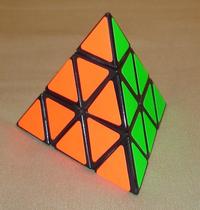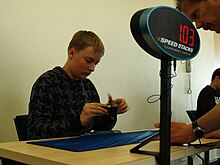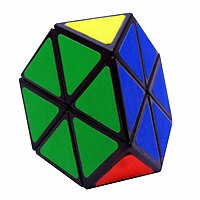Pyraminx

The Pyraminx (/ˈpɪrəmɪŋks/) is a regular tetrahedron puzzle in the style of Rubik's Cube. It was made and patented by Uwe Mèffert after the original 3 layered Rubik's Cube by Ernő Rubik, and introduced by Tomy Toys of Japan (then the 3rd largest toy company in the world) in 1981.[1]
Description
[edit]
The Pyraminx was first conceived by Mèffert in 1970. He did nothing with his design until 1981 when he applied for a patent on 27/03 (EP0042695 on 12/30/81) and brought it to Hong Kong for production. Uwe is fond of saying had it not been for Ernő Rubik's invention of the cube, his Pyraminx would have never been produced.[citation needed] Somewhat earlier (for 40 days) in the Soviet Union, the chief technologist of the Kishinev Tractor Plant, Alexander Alexandrovich Ordynets, filed his application for an invention (patent SU980739 dated 12/15/1982, with the filing date 02/18/81), because[clarification needed] of that, in Russia many people call the puzzle "Молдавская пирамидка" (Moldavian pyramid).
The Pyraminx is a puzzle in the shape of a regular tetrahedron, divided into 4 axial pieces, 6 edge pieces, and 4 trivial tips. It can be twisted along its cuts to permute its pieces. The axial pieces are octahedral in shape, although this is not immediately obvious, and can only rotate around the axis they are attached to. The 6 edge pieces can be freely permuted. The trivial tips are so called because they can be twisted independently of all other pieces, making them trivial to place in solved position. Meffert also produces a similar puzzle called the Tetraminx, which is the same as the Pyraminx except that the trivial tips are removed, turning the puzzle into a truncated tetrahedron.

The purpose of the Pyraminx is to scramble the colors, and then restore them to their original configuration.
The 4 tips can be easily rotated to line up with the axial piece they are respectively attached to, and the axial pieces are also easily rotated so that their colors line up with each other. This leaves only the 6 edge pieces as a real challenge to the puzzle. They can be solved by repeatedly applying two 4-twist sequences, which are mirror-image versions of each other. These sequences permute 3 edge pieces at a time and change their orientation differently, so that a combination of both sequences is sufficient to solve the puzzle. However, more efficient solutions (requiring a smaller total number of twists) are generally available (see below).
The twist of any axial piece is independent of the other three, as is the case with the tips. The six edges can be placed in 6!/2 positions and flipped in 25 ways, accounting for parity. Multiplying this by the 38 factor for the axial pieces gives 75,582,720 possible positions. However, setting the trivial tips to the right positions reduces the possibilities to 933,120, which is also the number of possible patterns on the Tetraminx. Setting the axial pieces as well reduces the figure to only 11,520, making this a rather simple puzzle to solve.
Optimal solutions
[edit]The maximum number of twists required to solve the Pyraminx is 11. There are 933,120 different positions (disregarding the trivial rotation of the tips), a number that is sufficiently small to allow a computer search for optimal solutions. The table below summarizes the result of such a search, stating the number p of positions that require n twists to solve the Pyraminx:[2]
n 0 1 2 3 4 5 6 7 8 9 10 11 p 1 8 48 288 1728 9896 51808 220111 480467 166276 2457 32
Records
[edit]
The world record fastest Pyraminx solve is 0.73 seconds, set by Simon Kellum of United States on 21 December 2023 at Middleton Meetup Thursday 2023. The world record fastest average of five Pyraminx solves (excluding fastest and slowest) is 1.43 seconds, set by Lingkun Jiang of China on 2nd March 2024 at Hangzhou Spring 2024 in Hangzhou, China.[3]
Top 5 solvers by Olympic average of 5 solves[5]
[edit]Methods
[edit]There are many methods for solving a Pyraminx. They can be split up into two main groups.
1) V First Methods - In these methods, two or three edges are solved first, and a set of algorithms, also called LL (last layer) algorithms, are used to solve the remainder of the puzzle.
2) Top First Methods- In these methods, three edges around a center piece are solved first, and the remainder of the puzzle is solved using a set of algorithms.
Common V first methods-
a) Layer by Layer - In this method, a face with all edges permuted is solved, and then the remaining puzzle is solved by a single algorithm from a set of 5.
b) Algorithmic L4E and Intuitive L4E - L4E or last 4 edges is somewhat similar to Layer by Layer. The only difference is that only two edges are solved around three centers. Both of these methods solve the last four edges in the same step, hence the name. The difference is that Intuitive L4E requires a lot of visualization and "intuition" to solve the last four edges while algorithmic L4E uses algorithms. Algorithmic L4E is generally used more at higher levels, although there are very fast Intuitive L4E users. It is also easy to transition between Intuitive L4E and Algorithmic L4E.
Common top first methods-
a) One Flip - This method uses two edges around one center solved and the third edge flipped. There are a total of six cases after this step, for which algorithms are memorized and executed. The third step involves using a common set of algorithms for all top first methods, also called Keyhole last layer, which involves 5 algorithms, four of them being the mirrors of each other.
b) Keyhole - This method uses two edges in the right place around one center, and the third edge placed elsewhere on the puzzle. The centers of the fourth color are then solved using the slot formed by the non-permuted edge. The last step is solved using Keyhole last layer algorithms.
c) OKA - In this method, one edge is oriented around two edges in the wrong place, but one of the edges that is in the wrong place belongs to the block itself. The last edge is found on the bottom layer, and a very simple algorithm is executed to get it in the right place, followed by keyhole last layer algorithms.
Some other common top first methods are WO and Nutella.
Many Pyraminx speedsolvers learn several methods, particularly top-first methods, and use the method that is best for the given solve.[6]
There is no consensus among pyraminx speedsolvers regarding whether top-first or v-first methods are faster, although v-first is more common in the present day.
Variations
[edit]
There are several variations of the puzzle. The simplest, Tetraminx, is equivalent to the (3x) Pyraminx but without the tips (see photo), resembling a truncated tetrahedron. There also exist "higher-order" versions, such as the 4x Master Pyraminx (see photos) and the 5x Professor's Pyraminx.


The Master Pyraminx has 4 layers and 16 triangles-per-face (compared to 3 layers and 9 triangles-per-face of the original), and is based on the Skewb Diamond mechanism. This version has about 2.6817 × 1015 combinations.[7][8] The Master Pyraminx has
- 4 "tips" (same as the original Pyraminx)
- 4 "middle axials" (same as the original Pyraminx)
- 4 "centers" (similar to Rubik's Cube, none in the original Pyraminx)
- 6 "inner edges" (similar to Rubik's Cube, none in the original Pyraminx)
- 12 "outer edges" (2-times more than the 6 of the original Pyraminx)
In summary, the Master Pyraminx has 30 "manipulable" pieces. However, like the original, 8 of the pieces (the tips and middle axials) are fixed in position (relative to each other) and can only be rotated in place. Also, the 4 centers are fixed in position and can only rotate (like the Rubik's Cube). So there are only 18 (30-8-4) "truly movable" pieces; since this is 10% fewer than the 20 "truly movable" pieces of the Rubik's Cube, it should be no surprise that the Master Pyraminx has about 10,000-times fewer combinations than a Rubik's Cube (43 quintilion in the short scale or 43 trilion in the long scale). The Master Pyraminx can be solved in numerous ways: one is layer by layer like the original one or reducing it to a Jing pyraminx.[9]
Reviews
[edit]See also
[edit]- Pyraminx Duo
- Pyramorphix and Master Pyramorphix, two regular tetrahedron puzzles which resemble the Pyraminx but are mechanically very different from it
- Pocket Cube
- Rubik's Cube
- Rubik's Revenge
- Rubik's Triamid
- Professor's Cube
- V-Cube 6
- V-Cube 7
- V-Cube 8
- Skewb
- Skewb Diamond
- Megaminx
- Dogic
- Combination puzzles
- Tower Cube
References
[edit]- ^ "Puzzles, Pyraminx, Twisting puzzles, Kokonotsu-Super-Sudoku, Megaminx, 5x5x5 cube".
- ^ Pyraminx - Jaap's Puzzle Page
- ^ "Pyraminx - Official World Records (Single and Average)". World Cube Association. Retrieved 7 July 2023.
- ^ World Cube Association Official Pyraminx Ranking Single
- ^ World Cube Association Official Pyraminx Ranking Average
- ^ World Cube Association - Drew Brads results.
- ^ "Full List of Puzzles". gandreas software. Archived from the original on 28 April 2016. Retrieved 31 December 2016.
- ^ "Notes on Twisty Puzzles". Michael Gottlieb. Retrieved 31 December 2016.
- ^ Martin Schönert "Analyzing Rubik's Cube with GAP": the permutation group of Rubik's Cube is examined with GAP computer algebra system
- ^ "GAMES Magazine #29". May 1982.
External links
[edit]- Jaap's Pyraminx and related puzzles page, with solution
- Pyraminx solution from PuzzleSolver
- Pyraminx - ruwix.com (how to solve)
- A solution to the Pyraminx[permanent dead link] by Jonathan Bowen
- An efficient and easy to follow solution favoured by speed solvers
- Patterns A collection of pretty patterns for the Pyraminx
